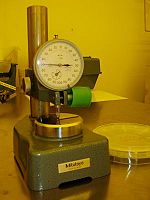Specific Process Knowledge/Characterization/Thickness Measurer: Difference between revisions
| Line 10: | Line 10: | ||
Doing a KOH etch can it be helpful to insure no over etching by making a thickness measurement doing the etch. | Doing a KOH etch can it be helpful to insure no over etching by making a thickness measurement doing the etch. | ||
We have two Thickness measures an analog and a digital one. | |||
'''The user manual, technical information and contact information can be found in LabManager:''' | '''The user manual, technical information and contact information can be found in LabManager:''' | ||
Revision as of 09:55, 14 January 2014
THIS PAGE IS UNDER CONSTRUCTION
Feedback to this page: click here
Thickness measurer

The purpose is to measure the thickness of wafers, depths of larger grooves or height of larger mesas.
Doing a KOH etch can it be helpful to insure no over etching by making a thickness measurement doing the etch.
We have two Thickness measures an analog and a digital one.
The user manual, technical information and contact information can be found in LabManager:
Quality Control - Recipe Parameters and Limits
| Quality Control (QC) for the Thickness measurer |
|
The measured standard thickness is 0.1 mm. The measured result have to be within +- 0.005 mm. The QC is preformed ones a year. |
|
Purpose |
Thickness measurer |
|
|---|---|---|
|
Performance |
Thickness resolution |
|
|
Process parameter range |
Process Temperature |
|
| Process pressure |
| |
|
Substrates |
Batch size |
|
| Substrate materials allowed |
|
Feedback to this page: click here
This is a micrometer-screw.

It measures with an accurracy within a few µm. The range is from a few µm up to 5mm. Measure the wafer in the box next to the meter. If this is ok, then other wafers can be measured. There is a calibration device by the DEKTAK. It is calibrated at 750µm.
